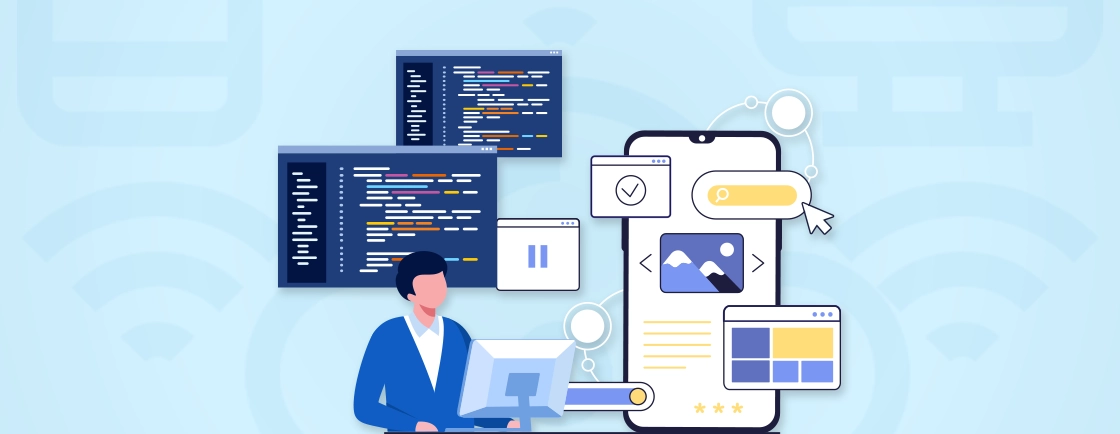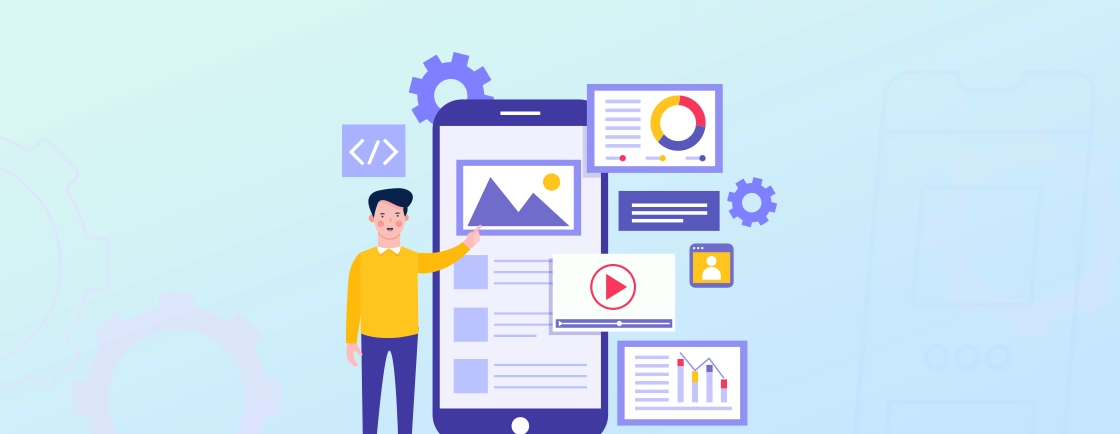Table of Contents
You must have heard this phrase, “There’s an app for everything.”. Whether you have Android or iOS, there are apps for every industry, eCommerce, food, groceries, gaming, healthcare, banking, and so many more.
So no matter your industry or domain, you need to develop a mobile app for ultimate reach and engagement. From ideation to launch, the process involves meticulous planning, robust development, and continuous iteration.
Through this blog, I’ll explain how our mobile app developers go about creating the best apps for both Android and iOS, and how you can do the same. Let’s begin with the “Why”.
Why Create a Mobile App?
In a world where convenience and accessibility are paramount, a mobile app isn’t just a tool—it’s a strategic asset for growth and impact. Here are a few of the potential benefits across industries.
Enhanced Customer Engagement
Mobile apps provide a direct and personalized channel to connect with users, offering features like push notifications, in-app messaging, and tailored content to keep them engaged.
Improved Brand Visibility
Having an app ensures your brand is always accessible, sitting right on users’ home screens and reinforcing your presence in their daily lives.
Streamlined User Experience
Apps are faster and more intuitive than websites, offering seamless navigation, offline functionality, and a smoother overall experience.
Increased Revenue Opportunities
Apps open doors to monetization through in-app purchases, subscriptions, ads, and e-commerce integrations, driving higher conversion rates.
Valuable Data Insights
Apps allow you to gather user behavior data, enabling you to make informed decisions, refine strategies, and deliver better products or services.
Investing in a mobile app can transform how you connect with your audience and grow your business.
Requirements for Mobile App Development
Effective mobile app development hinges on a blend of technical expertise and strategic planning. But before the process starts, you will have to take care of a few key requirements.
Clearly Defined Project Scope and Target Audience
Understanding who will use your app and what problem it solves is fundamental. This involves detailed market research, competitor analysis, and creating user personas.
A precise scope prevents feature creep and ensures development focuses on core functionalities that resonate with your target demographic.
Platform Selection (iOS, Android, or Cross-Platform)
You need to choose whether you want to create the app for the Apple App Store or the Google Play Store. Choosing the right platform influences the technology stack and development costs. iOS development often uses Swift or Objective-C, while Android leverages Java or Kotlin.
Cross-platform frameworks like React Native or Flutter offer the advantage of a single codebase for multiple platforms, but may have performance trade-offs. The decision should align with your target audience’s device preferences and your budget.
Skilled Development Team
A successful app requires a multidisciplinary team. The team will include the likes of:
- UI/UX designers: To create intuitive interfaces
- Front-end developers: To build the user-facing elements
- Back-end developers: To manage server-side logic and databases
- Quality assurance testers: To ensure a bug-free experience.
Effective communication and collaboration within the mobile development team are essential.
Appropriate Technology Stack, APIs, and SDKs
Selecting the right tools is critical for efficient development. This includes programming languages, frameworks, databases, and cloud services. APIs (Application Programming Interfaces) and SDKs (Software Development Kits) provide pre-built functionalities.
These can help accelerate mobile development and integrate external services like payment gateways or mapping tools.
Comprehensive Testing Strategy
Rigorous testing is essential to identify and fix bugs before launch. This includes unit testing, integration testing, user acceptance testing, and performance testing.
A well-defined testing strategy ensures the app functions smoothly across various devices and operating system versions.
Well-Defined Deployment and Maintenance Plan
A successful launch requires a strategic deployment plan, including app store optimization (ASO) and marketing efforts. Ongoing maintenance is crucial for addressing bugs, updating features, and ensuring compatibility with new operating system versions.
A plan for user feedback and iterative improvements is also vital.
How to Develop a Mobile App?
Developing a mobile app is a multi-step process that requires careful planning, execution, and iteration. Here’s a step-by-step guide for you.
Define the App Idea and Project Scope
The initial stage of mobile app development process involves crystallizing your app’s core purpose and identifying its unique value proposition. Clearly articulate the problem your app solves and the specific features it will offer. A well-defined scope prevents “feature creep” and ensures development remains focused.
Key Aspects
- Core problem/solution identification
- Unique value proposition articulation
- Target audience definition
- Feature prioritization
- Scope documentation
Documenting the app’s goals, target audience, and key functionalities creates a roadmap for the entire project.
Conduct Market Research
Validate your app idea by understanding the competitive landscape and target audience needs. Analyze existing apps, identify market gaps, and assess potential demand. Research user demographics, preferences, and pain points to inform design and functionality decisions.
Key Aspects
- Competitive analysis
- Target audience needs assessment
- Market gap identification
- Demand validation
- User persona development
This step minimizes risk and optimizes your app for market success.
Create a Detailed Project Plan
A comprehensive project plan outlines timelines, milestones, and resource allocation. Define development phases, assign responsibilities, and establish clear communication channels. Utilize project management tools to track progress and manage potential risks.
Key Aspects
- Timeline and milestone definition
- Resource allocation
- Task assignment
- Communication channel establishment
- Risk management
A well-structured plan ensures efficient development and timely delivery.
Design the UI & UX
User interface (UI) and user experience (UX) design are critical for app engagement. Create intuitive and visually appealing interfaces that prioritize usability. Develop wireframes and prototypes to visualize the app’s structure and flow. Conduct user testing to gather feedback and refine the design.
Key Aspects
- Intuitive interface design
- User-centered design principles
- Wireframing and prototyping
- Usability testing
- Visual design consistency
A seamless and enjoyable user experience fosters user retention.
Develop the App
This phase involves translating the design into functional code. Select the appropriate programming languages, frameworks, and development tools based on your chosen platform. Ensure clean, efficient, and well-documented code.
Key Aspects
- Platform-specific or cross-platform coding
- Back-end infrastructure development
- API and SDK integration
- Code quality and efficiency
- Database management
Implement robust back-end infrastructure to support app functionality and data management.
Test the App Design and Functionalities
Rigorous testing is essential to identify and resolve bugs, usability issues, and performance bottlenecks. Conduct various testing types, including unit testing, integration testing, and user acceptance testing. Test across multiple devices and operating system versions to ensure compatibility.
Key Aspects
- Unit testing
- Integration testing
- User acceptance testing
- Performance testing
- Cross-device compatibility testing
A comprehensive testing process guarantees a stable and reliable app.
Deploy the Application on the App Store
Prepare the app for release by optimizing it for app store guidelines and performance. Develop a launch strategy that includes app store optimization (ASO) and marketing efforts. Submit the app to the appropriate app stores (Apple App Store, Google Play Store).
Key Aspects
- App store optimization (ASO)
- Launch strategy implementation
- App store submission
- Initial user feedback monitoring
- Release version control
Monitor app store reviews and user feedback post-launch.
Monitor and Improve
Continuously monitor app performance, user engagement, and feedback. Utilize analytics tools to track key metrics and identify areas for improvement. Implement regular updates to address bugs, enhance features, and adapt to evolving user needs.
Key Aspects
- Performance analytics tracking
- User engagement monitoring
- Bug fixing and feature updates
- User feedback analysis
- Iterative development
A proactive approach to maintenance and updates ensures long-term app success. While this process would be enough to create a basic mobile app, a more advanced one would need more professional skills and expertise.
To build scalable and feature-rich applications, it’s best to partner with a Custom Mobile App Development Company that can turn your ideas into reality with the right tools and strategies.
Top Mobile App Development Platforms
When it comes to creating the best mobile apps, you have a variety of platforms available, across different categories, like native, cross-platform, and low-code/no-code. Let’s look at these platforms one-by-one.
Android Studio
Google’s official IDE, Android Studio, provides a comprehensive environment for native Android development. Its robust emulator and debugging tools empower developers to create high-performance, feature-rich applications tailored specifically for the Android ecosystem.
Pros
- Seamless integration with Google services.
- Advanced debugging and testing tools.
- Supports Kotlin, Java, and C++.
Cons
- Resource-intensive, requiring a powerful system.
- Limited to Android development.
Xcode
Exclusively for Apple platforms, Xcode is the cornerstone of iOS, macOS, watchOS, and tvOS development. Its seamless integration with Apple’s ecosystem and powerful interface builder enable developers to create polished, native applications.
Pros
- Intuitive interface with a visual editor.
- Integrated with Swift and Objective-C.
- Built-in simulator for testing.
Cons
- Exclusively for Apple platforms.
- Steeper learning curve for beginners.
Flutter
Google’s Flutter framework leverages a single codebase to build natively compiled applications for mobile, web, and desktop. Its “hot reload” feature accelerates development, while its expressive UI toolkit delivers visually appealing experiences.
Pros
- Fast development with hot reload.
- Consistent UI across platforms.
- Strong community support.
Cons
- Larger app size compared to native apps.
- Limited third-party libraries.
React Native
Developed by Facebook, React Native is used by developers for cross-platform mobile application development using JavaScript and React. Its component-based architecture and extensive community support facilitate rapid development and code reuse.
Pros
- Reusable code for iOS and Android.
- Large developer community.
- Live reload for faster iterations.
Cons
- Performance issues for complex apps.
- Limited native functionality.
Xamarin
Microsoft’s Xamarin allows developers to use C# and .NET to build cross-platform mobile apps. Its native UI performance and access to platform-specific APIs make it a strong choice for enterprise-grade applications.
Pros
- Native-like performance.
- Shared codebase for multiple platforms.
- Strong integration with Microsoft tools.
Cons
- Larger app size.
- Limited community support compared to others.
Ionic
Ionic uses web technologies (HTML, CSS, JavaScript) to build cross-platform mobile applications. Its focus on web standards and extensive UI components makes it accessible to web developers.
Pros
- Easy to learn for developers.
- Large library of plugins.
- Cost-effective for simple apps.
Cons
- Performance lags for graphics-intensive apps.
- Limited native functionality.
SwiftUI
Apple’s SwiftUI is a modern UI framework that simplifies the creation of user interfaces across all Apple platforms. Its declarative syntax and live preview features enhance developer productivity and streamline UI development.
Pros
- Simplified UI development.
- Real-time previews.
- Seamless integration with Apple ecosystems.
Cons
- Only supports iOS 13 and later.
- Limited to Apple platforms.
Kotlin
Google’s preferred language for Android development, Kotlin offers a modern, concise, and safe alternative to Java. Its interoperability with Java and robust features make it a popular choice for Android developers.
Pros
- Concise and expressive syntax.
- Enhanced safety features.
- Officially supported by Google for Android.
Cons
- Smaller talent pool compared to Java.
- Limited use outside Android development.
AppGyver
AppGyver is a no-code platform that empowers users to build mobile and web applications without writing code. Its visual editor and drag-and-drop interface make it accessible to non-technical users.
Pros
- No coding skills required.
- Rapid prototyping and development.
- Integrates with third-party services.
Cons
- Limited customization for complex apps.
- Dependency on platform updates.
Adobe PhoneGap
Adobe PhoneGap allows developers to build cross-platform mobile applications using web technologies. Its use of HTML, CSS, and JavaScript enables developers to leverage existing web development skills.
Pros
- Easy to use for developers.
- Supports multiple platforms.
- Large plugin library.
Cons
- Performance issues for heavy apps.
- Outdated compared to modern frameworks.
Each platform has its strengths, so the choice depends on your app’s requirements, target audience, and development expertise.
So, Want the Best Mobile App?
Successfully developing a mobile app requires a blend of strategic planning, technical expertise, and a user-centric approach. From defining your initial idea to navigating the complexities of app store deployment and ongoing maintenance, each stage plays a vital role in bringing your vision to life.
While the process may seem daunting, breaking it down into manageable steps, coupled with continuous learning and adaptation, significantly increases your chances of success.
If you want assistance with developing the best app, hire dedicated mobile app developers today!
FAQs on Mobile App Development
How much does it cost to develop a mobile app?
App development costs vary significantly, influenced by complexity, features, platform, and development team. A simple app might range from $10,000 to $50,000, while complex applications can exceed $100,000. Factors like UI/UX design, back-end infrastructure, and testing contribute to the overall cost.
How long does it take to develop a mobile app?
Development time depends on the app’s scope and complexity. A basic app might take 3-6 months, while complex apps can require 9-12 months or more. Planning, design, development, testing, and deployment all contribute to the timeline.
How do I monetize my mobile app?
Common monetization strategies include in-app purchases, subscriptions, advertising, freemium models, and paid downloads. The best approach depends on your app’s purpose and target audience.
Elevate Your App Development Journey
Explore comprehensive guides, industry trends, and expert advice to build innovative mobile applications.





